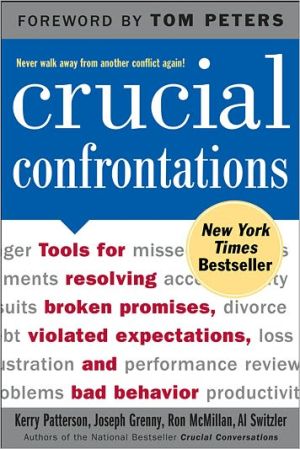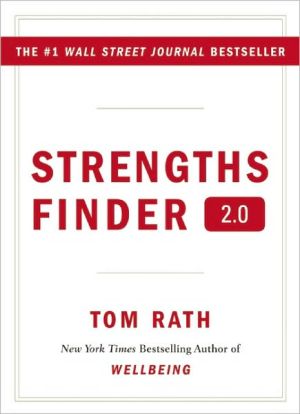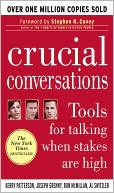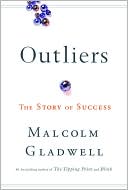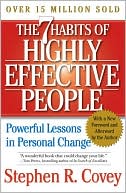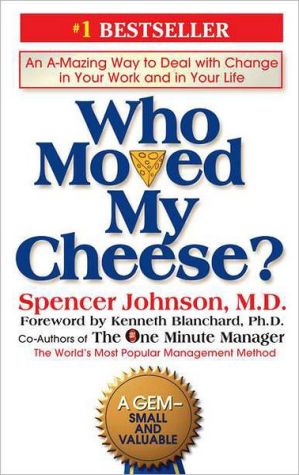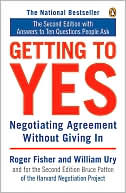Crucial Confrontations: Tools for Resolving Broken Promises, Violated Expectations, and Bad Behavior
The authors of the New York Times bestseller Crucial Conversations show you how to achieve personal, team, and organizational success by healing broken promises, resolving violated expectations, and influencing good behavior\ Discover skills to resolve touchy, controversial, and complex issues at work and at home—now available in this follow-up to the internationally popular Crucial Conversations.\ Behind the problems that routinely plague organizations and families, you'll find individuals...
Search in google:
"Hey, if you read only one 'management' book this decade...I'd insist that it be Crucial Confrontations."—from the foreword by TOM PETERS"Revolutionary ideas...opportunities for breakthrough..." — STEPHEN R. COVEY, author of The 7 Habits of Highly Effective People"...unleash the true potential of a relationship or organization and move it to the next level...."— KEN BLANCHARD, coauthor of The One Minute Manager® and The Secret: What Great Leaders Know—and Do"The most recommended and most effective resource in my library."— STACEY ALLERTON FIRTH, Vice President, Human Resources, Ford of Canada"Brilliant strategies for those difficult discussions at home and in the workplace..."—SOLEDAD O'BRIEN, cohost of CNN's Morning Edition"This book is the real deal....Read it, underline it, learn from it. It's a gem."— MIKE MURRAY, VP Human Resources and Administration, Microsoft (retired) NEVER WALK AWAY FROM ANOTHER TOUCHY, CONTROVERSIAL, OR COMPLEX ISSUE—AT WORK OR AT HOME! Behind the problems that routinely plague families, teams, and organizations are individuals who either can't or won't deal with failed promises. Others have broken rules, missed deadlines, or just plain behaved badly. If anybody steps up to the issue, they often do a lousy job and create a whole new set of problems.New research demonstrates that these disappointments aren't just irritating—they're costly—sapping organizational performance by 20 to 50 percent and accounting for up to 90 percent of divorces. Drawn from over 10,000 hours of real-life observations, Crucial Confrontations teaches skills to increase confidence in facing tough issues. Learn to: Permanently resolve failed promises and missed deadlines Transform broken rules and bad behaviors into productive accountability Strengthen relationships while solving problems Kerry Patterson has consulted with hundreds of Fortune 500 companies using his award-winning training program to teach development and maintenance of healthy organizations.Joseph Grenny has 20 years of experience coaching thousands of corporate and government leaders around the world in the art of communication.Ron McMillan cofounded and was the vice president of research and development of Covey Leadership Center.Al Switzler is currently on the faculty at the Executive Development Center at the University of Michigan.Together these authors have founded VitalSmarts and have trained more than 500,000 people world wide. They live in the greater Salt Lake City area. Soundview Executive Book Summaries Behind the problems that regularly plague families, teams and organizations are individuals who either can't or won't deal with failed promises. The reason is that they're afraid to talk face to face about difficult but important issues - and as their fear of confrontation prevents them from resolving these issues, simple problems grow into chronic problems.By learning how to deal with challenging confrontations, you'll learn to avoid the typical, but unconstructive, response of slipping either into awkward silence or embarrassing violence. Mastering crucial confrontations requires a skill set. In Crucial Confrontations, consultant Kerry Patterson and executive coach Joseph Grenny join forces with their fellow researchers and trainers Ron McMillan and Al Switzler to help others develop the skills it takes to resolve the most pressing problems, including quality violations, safety infractions, cost-cutting mistakes, and medical errors. The authors write that their research shows that most organizations are losing between 20 and 80 percent of their potential performance because they have not mastered crucial confrontations. The skills for mastering crucial confrontations can be learned; the authors of Crucial Confrontations show you how. What Is A Crucial Confrontation? Sarah, the head nurse at the Pine Valley Medical Center in northwestern Washington, stands frozen as doctors discuss the treatment of an elderly patient. Years of experience have taught Sarah two things: One, the patient probably needed an immediate and large dose of antibiotics, and two, even though the doctors were discussing a treatment that didn't involve antibiotics, Sarah would keep her mouth shut. Years earlier, fresh out of college, Sarah had cheerfully disagreed with the three doctors she had been assisting. They stopped dead in their tracks and looked at her as if she were a cockroach on a wedding cake. In one poignant moment that was forever burned into her psyche, the rules had been made clear to Sarah: Don't disagree with a physician - ever. Now, nearly two decades and hundreds of confirming incidents later, she stands by wondering: Will the doctors do what I believe they should do, or will they come to the same conclusion too late? She doesn't wonder if she should speak up. Sarah's expectations weren't met, and in response she has resorted to silence. Silence and Violence Staring into the face of a possible disaster, some people are caught in agonizing silence. Rather than speak directly and frankly about the problem at hand, they drop hints, change the subject, or actually withdraw from the interaction altogether. Fear drives them to various forms of silence and their point of view is never heard - except maybe as gossip or rumor. Others break away from their tortured inaction only to slip into violence. Frightened at the thought of not being heard, they try to force their ideas on others. They cut people off, overstate arguments, attack ideas, employ harsh debate tactics, and eventually resort to insults and threats. Fear drives them to do violence to the discussion and their ideas are often resisted. We all face crucial confrontations. We set clear expectations, but the other person doesn't live up to them - we feel disappointed. Lawyers call these incidents breaches of contract. What do you do when someone disappoints you? You could choose violence, or you could opt for another choice, like Sarah, and choose silence. But there is a method that falls somewhere between the polar worlds of fight and flight. Mastering crucial confrontations allows you to deal with failed promises, disappointments and other performance gaps. Unless you step up to and master crucial confrontations, nothing will get better. It will be a skill set, not a policy, which will enable you to solve pressing problems. If you can't effectively confront violated expectations, you eventually experience massive personal, social and organizational consequences. If you can't deal with performance gaps, you'll either fight or take flight. Productivity will run at half of what it should. If you learn how to hold people accountable in a way that solves problems without causing new ones, you can look forward to significant and lasting change. When you confront, you hold someone accountable, face to face. When confrontations are handled correctly, both parties are candid, open, honest and respectful. As a result, problems are resolved and relationships benefit. Crucial confrontation skills offer the best chance to succeed - no matter the topic, person or circumstance. Learn how to hold crucial confrontations and you'll never have to walk away from another conflict again.
Crucial Confrontations\ Tools for Resolving Broken Promises, Violated Expectations, and Bad Behavior \ \ By Kerry Patterson Joseph Grenny Ron McMillan Al Switzler \ McGraw-Hill\ Copyright © 2009 The McGraw-Hill Companies, Inc.\ All right reserved.\ ISBN: 978-0-07-144652-5 \ \ \ Chapter One\ Choose What and If \ I made a Freudian slip last night. I called my husband by the name of my first boyfriend. It was embarrassing. I did the same sort of thing. I meant to say to my husband, "Please pass the potatoes," but I said, "Die, loser; you've ruined my life!"\ How to Know What Crucial Confrontation to Hold and If You Should Hold It\ Problems rarely come in tiny boxes—certainly not the issues we care about. Those come in giant bundles. For instance, your in-laws just walked in unannounced while you were eating dinner. You've talked to them about giving you a heads-up, particularly if they plan on dropping in at dinnertime, and they still prance in on a whim. What problem do you address?\ You don't have enough food to go around. That could be easy to discuss. They've repeatedly promised they would notify you but are constantly breaking that agreement and losing your trust. That is likely to be hard to bring up. Finally, after turning down your invitation to join you at the table, they pout and whimper in the corner. That could be really difficult to confront.\ Let's try a work example. Your boss promises you a raise and then recants. This is the second time he's promised you something only to go back on the promise, except this time he dropped the bomb in a meeting, and so you couldn't complain on the spot. When you stopped him in the hallway to bring up the issue, he told you that he was in a hurry and said you should "stop being insensitive to my time demands." You asked if you could talk later, and he said, "Hey, I didn't get the money I deserved either."\ In each of these cases you're left with two questions that you have to answer before you open your mouth: What? and If? First, what violation or violations should you actually address? How do you dismantle a bundle of problems into its component parts and choose the one you want to confront? You have a lot to choose from, and you can't confront them all, at least not in one sitting. Second, you have to decide if you're going to say anything. Do you speak up and run the risk of causing a whole new set of problems, or do you remain silent and run the risk of never solving the problem?\ Let's take these two questions one at a time. We'll deal with the if question once we've resolved the what question.\ CHOOSING WHAT\ The question of what you should discuss may be the most important concept we cover in this book. When problems come in complicated bundles, and they often do, it's not always easy to know which problem or problems to address.\ For example, a teenage daughter swears to her father she'll be home from her first big date by midnight but doesn't come home until 1 a.m. Here's the pressing question: What problem should he confront? "That's easy," you say. "She was late." True, that's one way to describe the problem. Here are several other ways: She broke a promise. She violated her father's trust. She drove her father insane with fear that she had been killed in a car wreck. She purposely and willfully disobeyed a family rule. She openly defied her father in an effort to break free of parental control. She was getting even with her father for grounding her the weekend before. She knew it would drive her father bonkers if she stayed out late with a guy who sports a dozen face perforations, and so she did that.\ Although it's true that the daughter walked in the door 60 minutes after curfew, this may not be the exact and only problem her father wants to discuss. Here's the added danger: If he selects the wrong problem from this lengthy list of possible problems and handles it well, he may be left with the impression that he's done the right thing. However, if you want to join the ranks of the world's best problem solvers, you have to identify and deal with the right problem or it will never go away. This still leaves us with the question: What is the right problem?\ Signs That You're Dealing with the Wrong Problem\ Your Solution Doesn't Get You What You Really Want\ To get a feel for how to choose the right problem, let's look at an actual case we recently uncovered during a training session for school principals. It's from a grade school principal's experience. During recess a teacher notices the following interaction. Two second-grade girls are playing on the monkey bars. As Maria pushes Sarah to hurry her along, Sarah shouts, "Don't you ever touch me again, you dirty little Mexican!" Maria counters with, "At least I'm not a big fatty!" This is the precipitating event.\ The principal calls the children's parents, describes what took place, and explains that the school will be disciplining them. Maria's parents are fine with the idea and thank the principal, and that's the end of the discussion. Sarah's mother takes a different approach. She asks, "Exactly what form of discipline will each child receive?" The principal explains that the discipline will suit the nature of the offense.\ The next day Sarah's mother shows up unannounced, catches the principal in the hallway, and proclaims in loud and harsh tones that she doesn't want the school to discipline her daughter. She'll take care of the discipline on her own. The principal explains that the school is bound by public policy to take action. In fact, tomorrow Sarah will be separated from her friends during lunch and required to take her meal in the media room under the supervision of a teacher's aide. That's the prescribed discipline. Sarah's mother then announces that tomorrow she'll be picking up her daughter for a private mommy- daughter lunch at a nearby restaurant.\ There are several problems in this scenario. When the principals in the training session hear about the incident, many become emotional. "That's an easy one to figure out," some suggest. "You turn it over to the district discipline committee. Besides, since there are racial issues involved here, you could get the mother in trouble for interfering." Of course, the goal here isn't to cause the mother grief, so what should the principal do?\ As the principals settle down to discuss the problem in earnest, they bring to the surface an assortment of issues: "First, there's the problem of meddling. She has no right to ask about the other child's discipline. It's a private matter." "No, the bigger issue is that she is demanding to take away the school's right to discipline. That's simply unacceptable." "Plus the kid's going to be rewarded with a special lunch instead of being punished. Who wants that?" "How about the fact that the mother is rude and manipulative? That can't be good."\ Finally, one of the assistant principals brings up an issue that everyone seems to think is important: "I'm worried that the parent and the school won't be partnering in solving the problem. I'd want to work with the mother to come up with a plan jointly. Otherwise, she might begin to characterize the school officials as the enemy, and the child will soon agree."\ Once this important issue is highlighted as the main problem, a discussion can be held to resolve it and the principal can get what it is he or she really wants: a working partnership with the parent that will help benefit the child. Solutions to any of the other problems would not have accomplished this, and the frustration would have remained.\ So take note: if the solution you're applying doesn't get you the results you really want, it's likely you're dealing with the wrong problem entirely.\ You're Constantly Discussing the Same Issue\ Before we deal with the aggressive mother, let's look at another problem. This time you're working with the owner of a real estate firm in a rural community.\ "The woman who works the front desk is constantly coming in to work late," the owner explains.\ "Have you talked to her?" you ask.\ "Repeatedly."\ "And then what happens?" you continue.\ "She's on time for a few days, maybe even a week, and then she starts coming in late again."\ "Then what do you say to her?"\ "I tell her that she's late and that I don't like it."\ This situation presents a terrific example of what separates the best problem solvers from everyone else. The owner has the courage to confront the desk clerk. That separates him from the worst. However, the fact that he returns to the same problem each time puts him far below the best. This is an indication that there is some other problem that needs to be discussed: The front desk clerk isn't living up to her commitments, she's disrespecting company policy, etc.\ In summary, if you find yourself having the same problem-solving discussion over and over again, it's likely there's another, more important problem you need to address.\ You're Getting Increasingly Upset\ As you continue your conversation with the realtor, you say, "Obviously, the fact that your clerk comes in late is the behavior that catches your attention, and that's what you talk to her about. But what is the real problem here?"\ "I'm not exactly sure. I do know that it's starting to bug me a lot—more than it probably should."\ "Are you becoming more upset because the problem's escalating?"\ "Not really," the broker responds hesitantly.\ Finally, you ask: "When you're angry enough to complain to your wife, coworkers, or best friend about the problem, how do you describe it?"\ A light goes on in the broker's eyes as he excitedly states, "It's killing me that she's taking advantage of our relationship. She's my neighbor, she's helped me out a lot, and now she doesn't do what I ask because she knows that I won't discipline her since we're good friends. At least that's how it feels to me."\ That's the problem the broker needs to confront. He's becoming increasingly upset with each infraction because he's never dealt with the issue that is bothering him. Being late is the frozen tip floating above the chilly waters. Taking advantage of a friendship is the iceberg itself.\ Confronting the Right Issue\ As you can see from these examples, learning how to get at the gist of an infraction requires time and practice. Feeling pressured by time constraints and hyped up by emotions, most people miss the real deal. It takes grade-school assistant principals twenty minutes or more to discuss the assortment of challenges presented in the case of the aggressive mother. In fact, most never come to the realization that it's the lack of cooperation that they probably ought to discuss. Many can't get past their emotional reaction. They want to stick it to the feisty mother, and frankly, that's exactly what many would do.\ Along a similar vein, most parents who pace the floor nervously as a teenage daughter breaks curfew can't see beyond the hands of the clock when in truth what really has them concerned is the fact that the girl didn't have the courtesy to call them, let them know she'd be late, and bring a merciful end to their tortured worrying. Many don't even realize that this is what is troubling them.\ The ability to reduce an infraction to its bare essence takes patience, a sense of proportion, and precision. First, you have to take the time to unbundle the problem. People are often in too much of a hurry to do this. Their emotions propel them to move quickly, and speed rarely leads to careful thought. Second, while sorting through the issues you have to decide what is bothering you the most. If you don't, you'll end up going after either the wrong target or too many targets. Third, you have to be concise. You have to distill the issue to a single sentence. Lengthy problem descriptions only obscure the real issue. If you can't reduce a violation to a clear sentence before you talk, the issue almost never becomes more understandable and focused as a conversation unfolds.\ Helpful Tools to Get to the Right Confrontation\ Let's say that despite your best efforts you keep returning to the same problem. Your emotions are getting worse, not better, and in retrospect you believe that you're choosing to talk about what's easy, convenient, or obvious but not what's important. In short, you have every reason to believe that you're repeatedly dealing with the wrong problem. How do you turn this bad habit around? To hit the right target, use the following tools.\ Think CPR\ This acronym can help define a problem as well as eliminate Groundhog Day. The first time a problem comes up, talk about the Content, what just happened: "You drank too much at the luncheon, became inebriated, started talking too loud, made fun of our clients, and embarrassed the company." The content of a problem typically deals with a single event—the here and now.\ The next time the problem occurs, talk Pattern, what has been happening over time: "This is the second time this has occurred. You agreed it wouldn't happen again, and I'm concerned that I can't count on you to keep a promise." Pattern issues acknowledge that problems have histories and that histories make a difference. Frequent and continued violations affect the other person's predictability and eventually harm respect and trust.\ Warning: It's easy to miss the pattern and get sucked into debating content. For instance, your boss repeatedly leaves your agenda items to the end of the meeting—meaning that they typically get abbreviated or dropped altogether. You've spoken with her about it before. This time when you bring it up, she explains how full the agenda was and how you need to be more flexible about urgent issues. If you give in to that explanation, you've missed the point. Your concern is not today's meeting (the content issue), it's the long-standing pattern. Sometimes the pattern sneaks up on you and a new issue arises. You point out the problem, and the other person begins to either rant or pout, something that's starting to happen a lot in your conversations with him or her. It's becoming a pattern. Influential people notice this pattern of behavior and find ways to address it before moving back to the original topic.\ As the problem continues, talk about Relationship, what's happening to us. Relationship concerns are far bigger than either the content or the pattern. The issue is not that other people have disappointed you repeatedly; it's that the string of disappointments has caused you to lose trust in them: You doubt their competency, you don't respect or trust their promises, and this is affecting the way you treat one another: "This is starting to put a strain on how we work together. I feel like I have to nag you to keep you in line, and I don't like doing that. I guess my fear is that I can't trust you to keep the agreements you make."\ If your real concern is around the relationship and you discuss only the pattern of behavior, you're likely to find yourself feeling dissatisfied with the outcome. Even worse, you're likely to experience Groundhog Day: You'll have the same conversation again later. To understand the various kinds of content, pattern, and relationship issues that routinely pop up during crucial confrontations, consider the following three dimensions: consequences, intents, and wants. Each provides a distinct method for first unbundling and then prioritizing complex problems.\ Unbundling\ Consequences\ Problems are almost never contained in the behavior of the offender. They're much more likely to be contained in what happens afterward. The problem lies in the consequences. For example, a staff specialist who works for you is supposed to complete a financial analysis by noon. She miscalculates how long it will take and delivers the job to you three hours late.\ The errant behavior, being late, is not the problem. What follows is. The fact that you might lose a client is what really bothers you. Or maybe it's the fact that this is the third time this person has let you down and you're beginning to wonder if you can count on her. Or perhaps it's the fact that you now may have to watch this person more closely, costing you precious time and making her feel micromanaged. Each of these things comes after the behavior, is a consequence of the original act, and helps unbundle the problem.\ (Continues...)\ \ \ \ \ Excerpted from Crucial Confrontations by Kerry Patterson Joseph Grenny Ron McMillan Al Switzler Copyright © 2009 by The McGraw-Hill Companies, Inc.. Excerpted by permission of McGraw-Hill. All rights reserved. No part of this excerpt may be reproduced or reprinted without permission in writing from the publisher.\ Excerpts are provided by Dial-A-Book Inc. solely for the personal use of visitors to this web site. \ \
ForewordxiiiPrefacexviiAcknowledgmentsxviiiIntroduction: What's a Crucial Confrontation? And Who Cares?1Part 1Work on Me First: What to Do before a Crucial Confrontation23Ch. 1Choose What and If: How to Know What Crucial Confrontation to Hold and If You Should Hold It25Ch. 2Master My Stories: How to Get Your Head Right before Opening Your Mouth55Part 2Confront with Safety: What to Do during a Crucial Confrontation81Ch. 3Describe the Gap: How to Start a Crucial Confrontation83Ch. 4Make It Motivating: How to Help Others Want to Take Action113Ch. 5Make It Easy: How to Make Keeping Commitments (Almost) Painless145Ch. 6Stay Focused and Flexible: What to Do When Others Get Sidetracked, Scream, or Sulk171Part 3Move to Action: What to Do after a Crucial Confrontation199Ch. 7Agree on a Plan and Follow Up: How to Gain Commitment and Move to Action201Ch. 8Put It All Together: How to Solve Big, Sticky, Complicated Problems217Ch. 9The Twelve "Yeah-Buts": How to Deal with the Truly Tough231Appendix AWhere Do You Stand? A Self-Assessment for Measuring Your Crucial Confrontation Skills253Appendix BSix-Source Diagnostic Questions: The Six-Source Model258Appendix CWhen Things Go Right262Appendix DDiscussion Questions for Reading Groups269Notes271Index273
\ Soundview Executive Book SummariesBehind the problems that regularly plague families, teams and organizations are individuals who either can't or won't deal with failed promises. The reason is that they're afraid to talk face to face about difficult but important issues - and as their fear of confrontation prevents them from resolving these issues, simple problems grow into chronic problems.\ By learning how to deal with challenging confrontations, you'll learn to avoid the typical, but unconstructive, response of slipping either into awkward silence or embarrassing violence.\ Mastering crucial confrontations requires a skill set. In Crucial Confrontations, consultant Kerry Patterson and executive coach Joseph Grenny join forces with their fellow researchers and trainers Ron McMillan and Al Switzler to help others develop the skills it takes to resolve the most pressing problems, including quality violations, safety infractions, cost-cutting mistakes, and medical errors. The authors write that their research shows that most organizations are losing between 20 and 80 percent of their potential performance because they have not mastered crucial confrontations.\ The skills for mastering crucial confrontations can be learned; the authors of Crucial Confrontations show you how.\ What Is A Crucial Confrontation?\ Sarah, the head nurse at the Pine Valley Medical Center in northwestern Washington, stands frozen as doctors discuss the treatment of an elderly patient. Years of experience have taught Sarah two things: One, the patient probably needed an immediate and large dose of antibiotics, and two, even though the doctors were discussing a treatment that didn't involve antibiotics, Sarah would keep her mouth shut.\ Years earlier, fresh out of college, Sarah had cheerfully disagreed with the three doctors she had been assisting. They stopped dead in their tracks and looked at her as if she were a cockroach on a wedding cake. In one poignant moment that was forever burned into her psyche, the rules had been made clear to Sarah: Don't disagree with a physician - ever. Now, nearly two decades and hundreds of confirming incidents later, she stands by wondering: Will the doctors do what I believe they should do, or will they come to the same conclusion too late? She doesn't wonder if she should speak up. Sarah's expectations weren't met, and in response she has resorted to silence.\ Silence and Violence\ Staring into the face of a possible disaster, some people are caught in agonizing silence. Rather than speak directly and frankly about the problem at hand, they drop hints, change the subject, or actually withdraw from the interaction altogether. Fear drives them to various forms of silence and their point of view is never heard - except maybe as gossip or rumor.\ Others break away from their tortured inaction only to slip into violence. Frightened at the thought of not being heard, they try to force their ideas on others. They cut people off, overstate arguments, attack ideas, employ harsh debate tactics, and eventually resort to insults and threats. Fear drives them to do violence to the discussion and their ideas are often resisted.\ We all face crucial confrontations. We set clear expectations, but the other person doesn't live up to them - we feel disappointed. Lawyers call these incidents breaches of contract. What do you do when someone disappoints you? You could choose violence, or you could opt for another choice, like Sarah, and choose silence. But there is a method that falls somewhere between the polar worlds of fight and flight. Mastering crucial confrontations allows you to deal with failed promises, disappointments and other performance gaps.\ Unless you step up to and master crucial confrontations, nothing will get better. It will be a skill set, not a policy, which will enable you to solve pressing problems.\ If you can't effectively confront violated expectations, you eventually experience massive personal, social and organizational consequences. If you can't deal with performance gaps, you'll either fight or take flight. Productivity will run at half of what it should.\ If you learn how to hold people accountable in a way that solves problems without causing new ones, you can look forward to significant and lasting change.\ When you confront, you hold someone accountable, face to face. When confrontations are handled correctly, both parties are candid, open, honest and respectful. As a result, problems are resolved and relationships benefit. Crucial confrontation skills offer the best chance to succeed - no matter the topic, person or circumstance.\ Learn how to hold crucial confrontations and you'll never have to walk away from another conflict again.\ \ \
